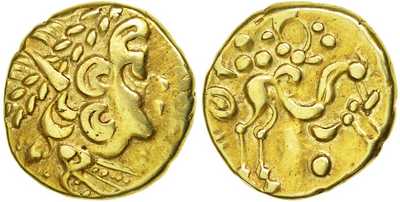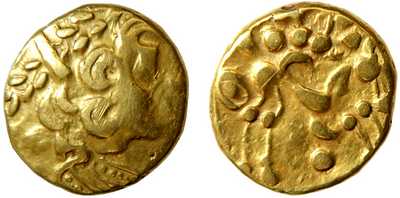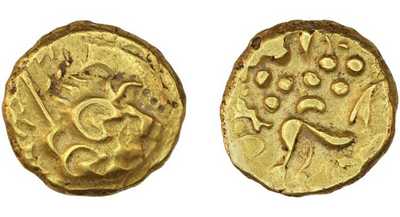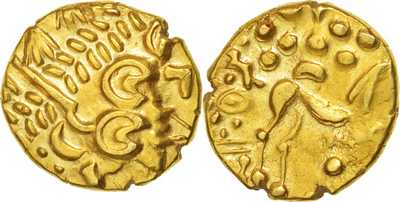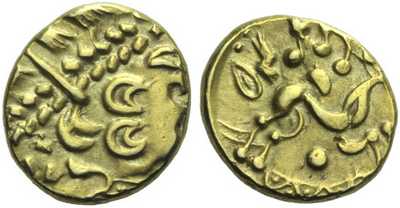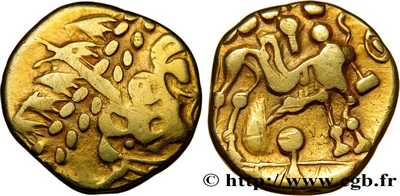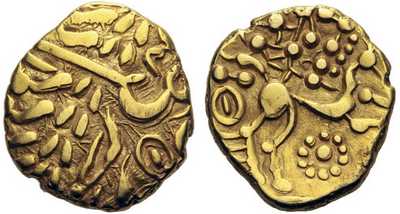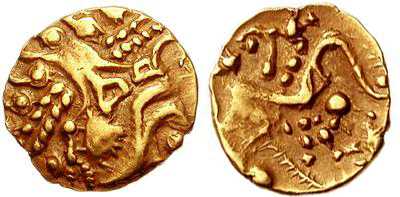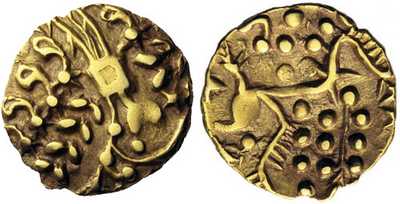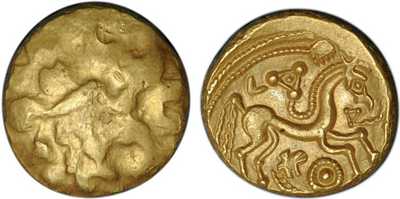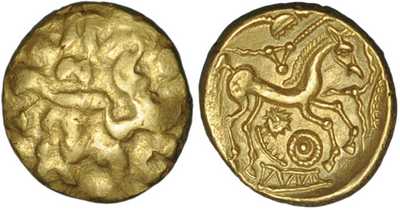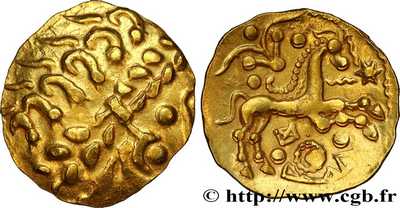| Back to Third Generation Coins (c. 125 BC to c. 50 BC) | This page is part of the article Getting Started with Celtic Coins | Forward to Gallo Belgic E |
John Sills (Gaulish and Early British Gold Coinage) has identified four different types of stater that were derived from Gallo-Belgic A. Many dealers and auction houses don’t use these sub-types, and just give them all a general “Gallo-Belgic C” classification (or more likely, “Gallo-Belgic Biface” or “Ambiani Biface”) and incorrectly assign them to the Ambiani. The four classes are:
There is also a Gallo-Belgic Cd, but that consists entirely of quarter staters.
Gallo-Belgic Ca
Gallo-Belgic Ca (125-58 BC) was a massive series of coins, with 6 classes, 62 obverses and 90 reverses known. Classes 1, 2, 4, 5 and 6 are found mainly in Gaul, but 90% of the class 3 finds are from Britain.
Class 3 was the biggest of the classes, and the only one (apart from the final class) where the obverse was allowed to wear flat. That, coupled with the fact that many of the reverse dies in this class were used with multiple obverse dies, suggests that class 3 was a single large batch that was minted in a hurry. The most likely reason for this is that class 3 represents a major payment to one or more tribes in the Kent region of Britain for military help against the Cimbri and the Teutoni, whom the Belgae coalition defeated in 103 BC.
Gallo-Belgic Ca continued to be minted until 58 BC when the Gallic Wars started. At this point, a coalition of Belgic tribes started minting a new series of coins, Gallo-Belgic E. Despite sharing the same dies as the very last coins of Gallo-Belgic Ca, Gallo-Belgic E coins were slightly lighter and with a lower gold content, probably in anticipation of the massive numbers that would be needed.
Class 1
This class die links with the end of Gallo-Belgic Aa.
Photo Copyright Leu Numismatik AG
Class 2
Photo Copyright NumisCorner.com
Class 3
Class 4
Photo Copyright Classical Numismatic Group, LLC
Class 5
Class 5 has 5a and 5b sub-classes. Class 5a has upward pointing leaves in the wreath, and class 5b has downward pointing leaves.
Photo Copyright Copyright © Trustees of the British Museum (CC BY-NC-SA 4.0)
Photo Copyright Comptoir des Monnaies
The reverse of this coin is the last one from class 5a and the first one of class 5b.
Class 6
Photo Copyright ogn-numismatique.com
Class E1
This coin isn’t a Gallo-Belgic Ca coin. It’s actually one of the very first Gallo-Belgic E coins. I’m including it here for a couple of reasons. Firstly, the two series are die linked through this obverse die, so this obverse was also used with Gallo-Belgic Ca coins. Secondly, Gallo-Belgic E is known as the Ambiani Uniface stater because the obverse is blank. This is of course incorrect. It was only blank on most of the coins. The very early ones, such as this one, had perfectly well formed obverses. The key point here is that the top of the exergue is flat, and that’s the start of Gallo-Belgic E. If it has a curve to it, it’s Gallo-Belgic Ca.
Photo Copyright Spink and Son Ltd
Gallo-Belgic Cb
Gallo-Belgic Cb is thought to have been minted by the Bellovaci, and was derived from Gallo-Belgic Ca, starting around Ca class 4. These coins are very similar to Gallo-Belgic Ca. The main distinguishing features are the small pellet at the base of the neck on the obverse, and the die flaws above and below the horse that develop over time.
Sills arranged the coins into 4 classes; 1a, 1b, 2a and 2b. The obverse die wears flat and class 2b is uniface, suggesting that Gallo Belgic Cb is contemporary with the latter half of Gallo-Belgic Ca (classes 4-6), which also became uniface at the start of the Gallic wars. A further hint that this is the case is that Ca class 4 coins and Cb class 1 coins are on the same weight standard.
Class 1a
Photo Copyright Comptoir des Monnaies
The dot is small, and the die break under the horse is just starting to form on this coin.
Class 1a ends with the obverse almost wearing flat.
Class 1b
Class 1b starts with a new obverse die, which is much like the die used in class 1a but with 1 three line cloak rather than a 5 line cloak. On the reverse, the ∩ shape above the horse is replaced by a set of interconnected pellets, much like those seen on Gallo-Belgic Ce class 2
I haven’t managed to find a photograph yet.
Class 2a
Photo Copyright CGB Numismatique Paris
Class 2b
Class 2b is just the uniface version of class 2a.
Photo Copyright CGB Numismatique Paris
Gallo-Belgic Cc
Gallo-Belgic Cc is a very rare series of coins that is thought to have been minted by the Eburones, although this is a very tentative attribution. Twenty of the thirty four known staters come from a single hoard, the Niederzier hoard, which also contained twenty six “Rainbow Cup” staters. These were minted by the Boii in Central Europe, making it possible that the coins were struck by the Ambiani for export to a tribe with Germanic links, such as the Eburones. The reasoning for this is that the obverse dies are so close to those of Gallo-Belgic Ca class 3 that the same engraver is thought to have carved them.
The reverse dies are also almost identical to those of Gallo-Belgic Ca class 3, the only difference being the presence of a rectangle with a splayed end above the “coffee bean” behind the horse.
Photo Copyright Oxford University & The Portable Antiquities Scheme (CC BY-SA 4.0)
Photo Copyright © Trustees of the British Museum (CC BY-NC-SA 4.0)
Gallo-Belgic Ce
Like Gallo-Belgic Ca, Gallo-Belgic Ce was derived from the earlier Gallo-Belgic Aa series of coins. It is thought that the three classes are contemporary with the first three classes of Ca. Despite being derived from Gallo-Belgic Aa, later Ce coins start to show influences from Ca and contemporary coins of the Parisii, making them some of the most interesting of the Gallo-Belgic C series.
They were probably minted by a small tribe called the Catuslougi (the Catoslugi mentioned by Pliny). I’ve also included photos of this class’s quarter staters because they are so distinctive.
Class 1
Coins of class 1 are very rare. Only two coins are known, and both of them are only known through drawings. The whereabouts of the actual coins themselves are unknown.
Class 2
Photo Copyright ogn-numismatique.com
Photo Copyright ogn-numismatique.com
Photo Copyright Classical Numismatic Group, LLC
Photo Copyright ogn-numismatique.com
Class 3
Photo Copyright CGB Numismatique Paris
Further Reading
- “Gaulish and Early British Gold Coinage” by Dr. John Sills
- “La Gaule Belgique - Traité De Numismatique Celtique” by Simone Scheers
Article Navigation
| Back to Third Generation Coins (c. 125 BC to c. 50 BC) | Up to Third Generation Coins (c. 125 BC to c. 50 BC) | Forward to Gallo Belgic E |

